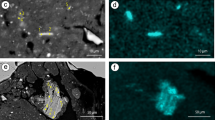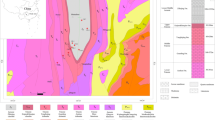Abstract
Mineralogical and 57Fe Mössbauer spectroscopic analyses were made on seven terrae rossae and two terrae fuscae samples of Pliocene to Early Pleistocene age from Slovakia and limestone residues from their parent materials. In most of the samples, no mineral weathering or clay mineral formation could be detected by optical or X-ray powder diffraction investigation, compared with their parent limestone residues; only one terra rossa showed a strong weathering of primary feldspar and phyllosilicates and a high rate of clay formation, especially kaolinite. Mössbauer measurements between 5° and 300°K showed that hematite and goethite are the dominant color pigments in the rubified terrae rossae and their corresponding limestone residues. The mean particle size of hematite and goethite was estimated from Mössbauer effects and X-ray powder diffraction data to be 95 and 250 Å, respectively. Reduced values of the hyperfine fields at 5°K of the soil iron oxides, as compared with those of the pure oxides, indicate a partial substitution of Fe(III) by Al. The hematite content correlates with the Munsell color notation of 5 of the 7 terrae rossae samples and their corresponding limestone residues. All terrae rossae samples showed higher hematite contents than their corresponding limestone residues, indicating that the rubification of such materials is independent of the degree of weathering.
Резюме
Минералогический и 57Fе Мессбауеровский спектральный анализы были проведены на семи образцах терра-росса и двух образцах терра-фюзе из эпохи от плиоцена до раннего плейстоцена в Словакии и на известняковых осадках из первоначальных материалов. В большинстве образцов ни выветривание, ни образование глинистых минералов не могут быть обнаружены при помощи оптической или порошковой рентгеновской диффракции по сравнению с их первоначальными известняковыми осадками. Только один образец терра-росса показал сильное выветривание первоначального фельдшпата и филлосиликатов и большую скорость образования глины, особенно каолинита. Мессбауеровские измерения между 5° и 300°К указали на то, что гематит и гетит являются главными цветовыми пигментами в красноватых образцах терра-росса и соответствующих им известняковых осадках. Средний размер частиц гематита и гетита был приблизительно оценен из данных эффектов Мессбауера и рентгеновской порош-ковой диффракции на 95 и 250 Å соответственно. Меньшие величины сверхтонких полей при 5°К почвенных окисей железа по сравнению с величинами чистых окисей указывают на частичную подстановку атомов Fе(Ш) атомами Аl. Содержание гематита соответствует минселловскому цветному коду для 5 из 7 образцов терра-росса и соответствующих им известняковых осадков. Все образцы терра-росса имели большее содержание гематита, чем соответствующие им известняковые осадки. Это указывает на то, что покраснение таких материалов является независимым от степени выветривания. [Е.О.]
Resümee
Sieben ausgewählte Terrae rossae pliozänen bis altpleistozänen Alters und zwei Terrae fuscae alt- bis mittelpleistozänen Alters und ihre jeweiligen Kalksteinlösungsrückstände aus der Slowakei wurden mineralogisch und mößbauerspektroskopisch untersucht. In fünf Terrae rossae ist im Vergleich zum jeweiligen Kalksteinlösungsrückstand keine Mineralverwitterung und Tonmineralbildung belegbar. In einer Terra rossa ist die Tonmineralbildung gering. Nur eine Terra rossa zeigt eine stärkere Verwitterung von primären Feldspäten und Phyllosilikaten und eine höhere Tonbildungsrate, insbesondere von Kaoliniten. Mößbauer-Messungen zwischen 5° und 300°K zeigen, daß Hämatite und Goethite die dominierenden Eisenoxide in den rubefizierten Terrae rossae einschließlich ihrer zugehörenden Kalksteinlösungsrückstände sind. Die mittleren Korngrößen von Hämatit und Goethit wurden aufgrund von Mößbauereffekt-Daten und Röntgenanalysen auf 95 bzw. 250 Å abgeschätzt. Reduzierte Werte der Hyperfeinfelder bei 5°K der Eisenoxide in den Böden im Vergleich zu reinen Eisenoxiden weisen auf eine partielle Substitution von Fe(III) durch Al hin. Bei fünf der sieben Terrae rossae und ihrer jeweiligen Kalksteinlösungsrückstände korreliert der Hämatitgehalt mit den Munsell-Farbwerten. Alle Terrae rossae zeigen höhere Hämatitgehalte als ihre jeweiligen Kalksteinlösungsrückstände. Das bedeutet, daß die Rubefizierung dieser Böden unabhängig von der Verwitterungsintensität ist.
Résumé
Des analyses minéralogiques et spectrographiques de Mössbauer 57Fe ont été faites sur sept échantillons de terrae rossae et sur deux échantillons de terrae fuscae du pliocène et du haut pleistocene de Slovaquie et sur des résidus calcaires des matériaux d’origine. Dans la plupart des échantillons, aucune altération minéralogique ni de formation de minéral argileux ne pouvait être détectée par investigation optique ou de diffraction poudrée de rayons-X, comparé aux résidus calcaires d’origine; une seule terra rossa a montré une forte altération de feldspar primaire et des phyllosilicates, et un taux élevé de formation d’argile, spécialement de la kaolinite. Des mesures de Mössbauer entre 5° et 300°K ont montré que l’hématite et la goethite étaient les piments de coloration dominants dans les terrae rossae rubifiées et leurs résidus calcaires correspondants. La taille moyenne de la particule d’hématite et de goethite a été estimée à partir des effets de Mössbauer et des données de diffraction poudrée des rayons-X à 95 et 250 Å, respectivement. Des valeurs réduites des champs hyperfins à 5°K des oxides de fer de sols, comparé à celles d’oxides purs, indiquent une substitution partielle de Fe(III) par Al. Le contenu en hématite s’accorde avec la notation de couleur Munsell de 5 des 7 échantillons terrae rossae et leurs résidus calcaires correspon dants. Tous les échantillons de terrae rossae ont montré des contenus en hématite plus élevés que leurs résidus calcaires correspondants, indiquant que la rubification de tels matériaux est indépendante de degré d’altération. [D.J.]
Similar content being viewed by others
References
Bigham, J. M., Golden, D. C., Buol, S. W., Weed, S. B., and Bowen, L. H. (1978) Iron oxide mineralogy of well-drained ultisols and oxisols: II. Influence on color, surface area, and phosphate retention: Soil Sci. Soc. Amer. J. 42, 825–830.
Bresson, L. M. (1974) A study of integrated microscopy: rubéfaction under wet temperate climate in comparison with Mediterranean rubéfaction: in Soil Microscopy, G. K. Rutherford, ed., Limestone Press, Kingston, Canada, 526–541.
Bronger, A. (1976a) Zur quartären Klima- und Landschaftsentwicklung des Karpatenbeckens auf paläopedologjscher und bodengeographischer Grundlage: Kieler Geographische Schriften 45, 1–268.
Bronger, A. (1976b) Kalksteinverwitterungslehme als Klimazeugen?: Z. Geomorph. N. F., Suppl.-Bd. 24, 138–148.
Bronger, A., Kalk, E., and Schröder, D. (1976) Über Glimmer- und Feldspatverwitterung sowie Entstehung und Umwandlung von Tonmineralen in rezenten und fossilen Lößböden: Geoderma 16, 21–54.
Bronger, A. and Smolíková, L. (1981) Herkunft der Terrae calcis in der Slowakei: Vestnik Ustr. Ust. Geolog. 56, 145–156.
Ćirić, M. and Alexandrović, D. (1959) A view on the genesis of terra rossa: Zbornik Radova Poljoprivrednog Fakuteta 7, 1–12 (published for the National Science Foundation, Washington D.C. and the U.S. Department of Agriculture, 1961).
Fleisch, J., Grimm, R., Grübler, J., and Gütlich, P. (1980) Determination of the aluminum content of natural and synthetic alumogoethite using Mössbauer spectroscopy: J. Physique, Collogue Cl, suppl. 41, 169–170.
Forsyth, J. B., Hedley, I. G., and Johnson, C. E. (1968) The magnetic structure and hyperfine field of goethite (α-FeOOH): J. Phys. Chem. 1, 179–188.
Gebhardt, H., King, M.-T., and Meyer, B. (1969) Mineralogischemische Untersuchungen zum Prozess der Rubifizierung in Kalkstein-Rotlehmen und fossilem Latent in Nord-Hessen: Göttinger Bodenkundl. Berichte 9, 65–124.
Golden, D. C., Bowen, L. H., Weed, S. B., and Bigham, J. M. (1979) Mössbauer studies of synthetic and soil-occurring aluminum-substituted goethites: Soil Sci. Soc. Amer. J. 43, 802–808.
Greenwood, N. N. and Gibb, T. C. (1971) Mössbauer Spectroscopy: Chapman and Hall, London, 239–303.
Janot, C. and Gibert, H. (1970) Les constituants du fer dans certaines bauxites naturelles étudiées par effet Mössbauer: Bull. Soc. Fr. Minéral. Cristallogr. 93, 213–223.
Klug, H. P. and Alexander, L. E. (1954) X-Ray Diffraction Procedures For Polycrystalline and Amorphous Materials: Wiley, New York, 491–538.
Kubiena, W. L. (1970) Micromorphological Features in Soil Geography: Rutgers University Press, New Brunswick, N.J., p. 240.
Kündig, W., Bommel, H., Constabaris, G., and Lindquist, R. H. (1966) Some properties of supported small α-Fe2O3 particles determined with the Mössbauer effect: Phys. Rev. 142, 327–332.
Mehra, O. P. and Jackson, M. L. (1960) Iron oxide removal from soils and clays by a dithionite-citrate system buffered with sodium bicarbonate: in Clays and Clay Minerals, Proc. 7th Natl. Conf, Washington, D.s 1958, Ada Swinford, ed., Pergamon Press, New York, 317–327.
Meisel, W. and Kreysa, G. (1973) Relative Moasbauerkonstanten von Eisenverbindungen zur quantitativen Analyse von Gemischen: Z. Anorg. Allg. Chem. 395, 31–36.
Meyer, B. and Kruse, W. (1970) Untersuchungen zum Prozess der Rubifizierung (Entkalkungsrötung) mediterraner Böden am Beispiel kalkhaltiger marokkanischer Küsten-Dünen: Göttinger Bodenkundl. Berichte 13, 77–140.
Mørup, S. and Topsøe, H. (1976) Mössbauer studies of thermal excitations in magnetically ordered microcrystals: Appl. Phys. 11, 63–66.
Norrish, K. and Taylor, R. M. (1961) The isomorphous replacement of iron by aluminum in soil goethites: J. Soil Sci. 12, 294–306.
Schulze, D. G. (1981) Identification of soil iron oxide minerals by differential X-ray diffraction: Soil Sci. Soc. Amer. J. 45, 437–440.
Schwertmann, U., Fitzpatrick, R. W., Taylor, R. M., and Lewis, D. G. (1979) The influence of aluminum on iron oxides, II. Preparation and properties of Al-substituted hematites: Clays & Clay Minerals 27, 105–112.
Schwertmann, U., Murad, E., and Schulze, D.G. (1982) Is there Holocene hematite formation in soils under humid temperate climate?: Geoderma 27, 209–223.
Shinjo, T. (1966) Mössbauer effect in antiferromagnetic fine particles: J. Phys. Soc. Japan 21, 917–922.
Smolíková, L. (1963) Stratigraphische Bedeutung der Terrae calcic-Böden: Antropozoikum, rada A, Sv. 1, 101–126.
Smolíková, L. and Ložek, V. (1962) Zur Altersfrage der mitteleuropäischen Terrae calcis: Eiszeitalter und Gegenwart 13, 155–177.
Thiel, R. (1963) Zum System α-FeOOH-α-AlOOH: Z. Anorg. Allg. Chem. 326, 70–78.
Van der Kraan, A. M. (1972) Mössbauer effect studies of superparamagnetic α-FeOOH and α-Fe2O3: theses Krips Repro N. V.-Meppel, University of Delft, The Netherlands, 48–115.
Van der Woude, F. (1966) Mössbauer effect in α-Fe2O3: Phys. Stat. Sol. 17, 417–432.
Author information
Authors and Affiliations
Additional information
An intensely weathered alfisol with a dense, clayey fabric containing a few skeleton grains, almost completely quartz, and very few voids (Kubiena, 1970).
Rights and permissions
About this article
Cite this article
Bronger, A., Ensling, J., Gütlich, P. et al. Rubification of Terrae Rossae in Slovakia: A Mössbauer Effect Study. Clays Clay Miner. 31, 269–276 (1983). https://doi.org/10.1346/CCMN.1983.0310404
Received:
Accepted:
Published:
Issue Date:
DOI: https://doi.org/10.1346/CCMN.1983.0310404




